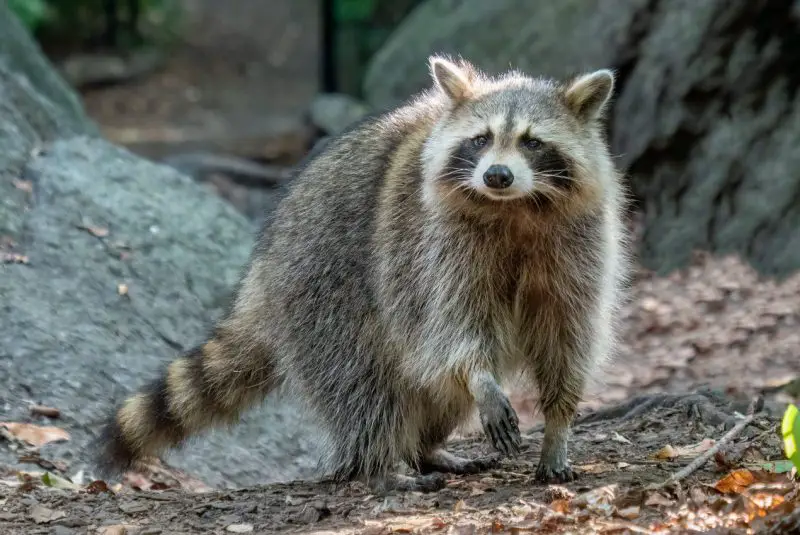Across North America, raccoons are easily distinguished by their signature face mask and striped tails. In Arizona, these intelligent and adaptable animals are more common than many people realize. Despite being associated with woodlands and wetlands in other parts of the United States, raccoons have managed to establish themselves in diverse habitats across the state, ranging from riparian forests to suburban neighborhoods.
Arizona is home to one primary species of raccoon, but within this species, their behavior and lifestyle can vary depending on where they live. Their adaptability, diet, and nocturnal habits allow them to thrive in both natural and human-influenced environments. This makes them an important part of the state’s ecosystem while also bringing them into occasional conflict with people.
In this article, we will explore the types of raccoons found in Arizona, their lifestyle, physical traits, feeding behavior, reproduction, and the best places where you might encounter them. We will also share interesting facts about these animals that highlight why they remain a fascinating subject for both wildlife enthusiasts and casual observers.
Types of Raccoons Found in Arizona

Arizona is primarily home to the common raccoon (Procyon lotor). This species is widespread throughout North America and is easily identified by its black “bandit mask,” dense grayish-brown fur, and bushy tail marked with alternating dark rings. Though only one main species is present in the state, raccoons in Arizona show slight regional differences in behavior depending on whether they inhabit desert fringes, mountainous woodlands, or riparian zones.
The raccoon’s adaptability to different ecosystems makes it a highly successful species. In Arizona’s cooler, forested regions, raccoons behave much like their northern counterparts, relying heavily on natural food sources such as insects, amphibians, and plant matter. In the drier desert regions, however, they may depend more on water-rich plants, agricultural crops, and even human refuse.
Interestingly, raccoons in Arizona are not native to the state in the same way as desert species like the kit fox or javelina. Historical evidence suggests that raccoons expanded their range into Arizona over time, aided by human development and changes in water management that created riparian habitats along rivers and canals.
Physical Characteristics and Identification
Raccoons in Arizona typically weigh between 10 and 20 pounds, though larger individuals may reach 25 pounds. Their body length averages 16 to 28 inches, with an additional 8 to 12 inches for the tail. Males are generally larger than females, and their sturdy build allows them to climb, dig, and swim with ease.
The most distinguishing feature of the raccoon is its facial mask—a black band across the eyes that contrasts with lighter fur around the face. This feature not only makes them unmistakable but also helps reduce glare and improve night vision, an advantage for a nocturnal predator. Their tail, with its dark rings, adds balance when climbing trees and navigating narrow ledges.
Raccoons have dexterous front paws with five elongated toes, resembling tiny human hands. These paws give them remarkable ability to manipulate objects, open containers, and even unlatch simple locks. In Arizona, where they sometimes raid trash bins or explore irrigation systems, this skill allows them to exploit resources that many other animals cannot.
Habitat and Distribution in Arizona
Raccoons are strongly tied to the presence of water. In Arizona, they are most commonly found along rivers, streams, and lakes, particularly in riparian zones where vegetation provides food and cover. They are especially abundant along the Salt River, Verde River, San Pedro River, and other waterways that cut through desert landscapes.
In mountainous areas such as the Mogollon Rim and White Mountains, raccoons thrive in mixed forests where they can find ample food and denning sites. They are also present in urban and suburban settings, particularly around Phoenix, Tucson, and Flagstaff, where artificial water sources, gardens, and trash bins provide easy food.
Although raccoons are not as visible in arid desert basins far from water, they can still be found in isolated oases, agricultural canals, and areas with stock tanks. Their ability to adapt allows them to survive even in regions that appear inhospitable at first glance.
Behavior and Lifestyle
Raccoons are primarily nocturnal, emerging at dusk to search for food and returning to their dens before sunrise. They are solitary for most of the year, though females with young remain together in family groups. Males maintain larger home ranges, often overlapping with several females, while females tend to restrict their movements to areas close to reliable food and water sources.
Despite their reputation as cunning “bandits,” raccoons are not aggressive by nature. They prefer to avoid humans and will retreat if threatened. However, when cornered, they can defend themselves vigorously using their sharp teeth and claws. In Arizona, encounters often occur near water sources where raccoons come to forage.
During colder months in northern Arizona, raccoons reduce their activity but do not truly hibernate. Instead, they enter a state of torpor, conserving energy and emerging on warmer nights to feed. In lower desert regions, raccoons remain active year-round, adjusting their schedules to avoid the extreme daytime heat.
Feeding Habits and Hunting Behavior
Raccoons are omnivores, consuming a varied diet that allows them to adapt to whatever environment they inhabit. In Arizona’s riparian zones, they feed heavily on crayfish, frogs, fish, and aquatic insects. They also eat fruits, berries, acorns, and corn when available.
In desert habitats, raccoons consume prickly pear cactus fruit, mesquite beans, and other native plants. They are also opportunistic scavengers, feeding on carrion or human food waste. Around agricultural lands, they sometimes raid melon fields, corn patches, or chicken coops, leading to conflicts with farmers.
One of the raccoon’s most fascinating behaviors is its tendency to “wash” food in water before eating. While this has sparked myths about cleanliness, the behavior is more about enhancing tactile sensitivity. The paws contain a high concentration of nerve endings, and wetting food allows raccoons to better feel textures and shapes.
Reproduction and Family Life
The breeding season for raccoons in Arizona typically occurs between January and March, though timing can vary with climate and food availability. Males may roam widely during this period in search of receptive females. After mating, the male leaves, and the female assumes all responsibility for raising the young.
Gestation lasts about 63 days, and litters usually consist of two to five kits, though larger litters can occur. The young are born blind and helpless, relying entirely on their mother for warmth and nourishment. By the time they are eight weeks old, the kits begin exploring outside the den under their mother’s supervision.
By autumn, the young raccoons are skilled enough to forage independently, though they may remain with their mother until the following spring. High juvenile survival in Arizona is aided by mild winters and abundant food sources in riparian zones and urban areas.
Fun Facts About Raccoons in Arizona
Raccoons are one of the few wild mammals that thrive in close proximity to humans. In Arizona cities, they are often spotted near golf course lakes, urban canals, and even backyard pools. Their curiosity frequently brings them into contact with people, though they remain wary and elusive.
Another interesting fact is that raccoons are excellent swimmers. In Arizona’s river systems, they can swim across strong currents to reach feeding grounds or escape predators. Their ability to climb also makes them highly versatile, and they are known to nest in tree cavities, attics, or abandoned burrows.
Raccoons also have impressive intelligence. Studies have shown they can remember solutions to tasks for up to three years, and in urban Arizona settings, they quickly learn to open latches, topple trash cans, and exploit pet food left outdoors. This intelligence contributes greatly to their survival in both wild and human-altered landscapes.
Where to See Raccoons in Arizona
For wildlife enthusiasts hoping to see raccoons, the best opportunities are during the evening along rivers, lakes, and riparian corridors. Locations such as the Riparian Preserve at Water Ranch in Gilbert, the San Pedro Riparian National Conservation Area, and parts of Tonto National Forest provide excellent habitats where raccoons are active.
In the Phoenix and Tucson metro areas, raccoons are often encountered in neighborhoods near canals and golf courses, though sightings may be brief due to their nocturnal habits. Campers and hikers in northern Arizona forests also have frequent raccoon encounters, especially near water or campsites where food is left unattended.
Though not as frequently observed as other desert animals, raccoons are present in surprising numbers across the state. Patience, quiet observation, and visiting areas near water at dusk offer the best chances of spotting these intelligent creatures.
Conclusion
Raccoons in Arizona are a remarkable example of adaptability and resilience. Despite the state’s arid climate, these animals have carved out niches in riparian zones, forests, deserts, and even urban environments. Their unique physical traits, nocturnal lifestyle, diverse diet, and intelligence make them one of the most fascinating mammals in the region.
From the forests of northern Arizona to the canals of Phoenix, raccoons are more widespread than many people assume. Understanding their behavior, reproduction, and habitat not only deepens appreciation for these clever creatures but also highlights their role in Arizona’s ecosystems. Whether you encounter them along a desert riverbank or in your own backyard, raccoons remain a captivating part of the state’s wildlife heritage.
FAQs About Raccoons in Arizona
Are raccoons common in Arizona?
Yes, raccoons are quite common in Arizona, particularly in areas near rivers, lakes, and streams. They are frequently found in riparian zones, mountain forests, and even urban environments where water and food are available. Though they are more secretive than other desert animals, their numbers are stable across the state.
What type of raccoon lives in Arizona?
The main species of raccoon in Arizona is the common raccoon (Procyon lotor). This is the same species found throughout North America, easily recognized by its black facial mask and ringed tail. While there are no subspecies unique to Arizona, raccoons in the state have adapted well to desert and riparian conditions.
Where are raccoons most often seen in Arizona?
Raccoons are most often spotted in riparian habitats such as along the Salt River, Verde River, San Pedro River, and near lakes or reservoirs. In cities like Phoenix and Tucson, they can also be seen around canals, golf courses, and neighborhoods with accessible food and water sources. Evening and night hours provide the best chance of sightings.
What do raccoons eat in Arizona?
Raccoons in Arizona eat a wide variety of foods, including crayfish, fish, frogs, insects, fruits, and acorns. In desert areas, they feed on prickly pear fruit, mesquite beans, and even agricultural crops. In urban settings, they often scavenge human food waste, pet food, and garden produce. Their omnivorous diet makes them highly adaptable.
Are raccoons dangerous to humans in Arizona?
Generally, raccoons are not dangerous to humans and prefer to avoid contact. However, they can become aggressive if cornered or threatened. The biggest concern with raccoons is the potential spread of diseases such as rabies or leptospirosis. For this reason, people should never attempt to feed or handle wild raccoons.
Do raccoons hibernate in Arizona?
Raccoons do not hibernate in Arizona. In the colder northern parts of the state, they may enter a state of torpor during winter, reducing their activity and conserving energy. In the warmer desert and lowland areas, they remain active year-round, adjusting their habits to avoid the extreme daytime heat.
How big do raccoons get in Arizona?
Most raccoons in Arizona weigh between 10 and 20 pounds, though some larger individuals can reach up to 25 pounds. They measure 16 to 28 inches in body length, with an additional 8 to 12 inches for the tail. Males are usually larger and heavier than females.
Do raccoons climb and swim?
Yes, raccoons are excellent climbers and strong swimmers. In Arizona, they frequently climb trees to find food or seek shelter, and they swim across rivers and canals to reach feeding areas. Their agility and versatility help them survive in diverse environments.
When is the raccoon breeding season in Arizona?
Raccoons breed from January to March in most parts of Arizona. After a gestation period of about 63 days, females give birth to litters of two to five kits. The young stay with their mother through the summer and often remain with her until the following spring.
What should you do if you see a raccoon in your yard?
If you spot a raccoon in your yard, the best approach is to observe it from a safe distance and avoid interaction. Make sure trash bins are secured, pet food is removed at night, and potential denning spots such as attics are sealed. Raccoons usually move on once they find no easy food sources.






